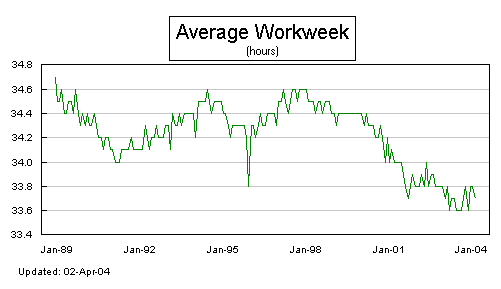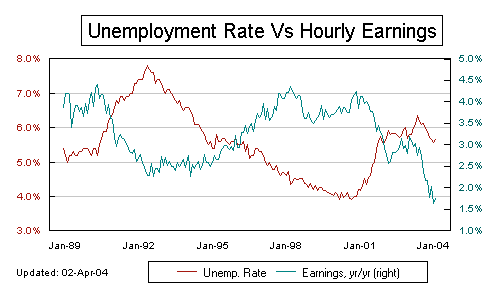This Foe is Beyond You, Mr. Magoo
Does the Fed really look at wages when deciding whether to raise rates? History suggests it does. The below from Greg Weldon today on the very issue. The issue is the role of final (consumer) demand on inflation. Without final demand...inflation can't really heat up (at least that appeared to be true until China came into play.) The Fed may find itself in a bizarre new world--unable to contain inflation caused by Chinese demand for raw materials...and unable to reverse wage deflation...caused by Chinese supply of cheap labor. Of course I shouldn't hang it all on the Chinese. And these adverse side effects (from the American wage earner's perspective) are the natural results of free markets. What the Fed, and investors, appear to have missed in all this is that monetary policy alone can't solve this problem. As Gandalf said about the Balrog in the mines of Moria, "This foe is beyond any of you. Run!" To the extent that disinflating wages are a national problem...they would require a larger strategic approach. Manipulating interest rates, to use the military metaphor, is simply a tactic. A Grand Strategy, like the one I've suggested the Chinese are pursuing, would start with a simple question: Is it possible to form a national economic policy that guarantees Americans a certain standard of living? That's an ambitious question, of course. And up to now, free market intellectuals have been inclined to say that the freer the trade, the greater the prosperity. Could be. But the truth is, none of us has ever really lived through a period where labor and capital move as freely as they do today. Could the idea that the mobility of labor and capital leads irresistibly to greater prosperity be just naive American faith in free markets? After all, free markets are competitive. They don't benignly bestow affluence on everyone. True, they tend to produce better goods and services at lower prices. Competition, as Hayek once said, is decentralized planning. That is, competition is the result of planning by numerous individuals...plans to compete, to save, to invest, to take risk prudently. The more competitive a marketplace the greater the quantity and quality of goods, and the cheaper the price. I'm inclined to say that rather than adopting a national Grand Strategy of competition between nation states (didn't work so well in 1914...why would it work any better now), Americans are better off getting back to competing harder in the free market. Not that that will be easy. To compete, you have to have an advantage. And right now, it's hard to see what kind of competitive advantage the American economy has. Education? Cost of labor? High savings rate? Technological savvy? Moxy? Dynamism? The language? Rather than thinking about the economy as a whole, why not think about things closer to home first? We think in terms of national and political solutions these days. Everything in our culture encourages to think about social solutions. All problems become political problems and seemingly demand a political solution. Does anyone take seriously Adam Smith's idea that by pursuing your own ends--and not presuming to know what's best for the world--you indirectly, through the invisible hand, improve the lot of your neighbor? Do you believe that? I still do. Which is why I think the best solution to America's competitive problem is being fiscally responsible for yourself, your family, and your friends. That means not going broke in the stock market, getting blindsided by a panic in the housing market, or tied to the mast of the dollar as the ship sinks. And even if I'm wrong about the big risks in the economy, being an investor in a globalized world means you still have a lot of opportunities to stay well ahead of the storm. In the meantime...I'll post the non-farm payrolls report when it comes out. But here are the straight facts on Fed rate increases and wage growth from Weldon. The important point: the Fed doesn't historically tighten until wages pick up and capacity utilization increases. If history holds, the Fed won't raise until those two things change. "We note the following macro-details as apply to the averages noted in past period linked to phases where the Fed BEGINS to tighten monetary policy (nine occasions since 1967). *`Average year-year change in Average Hourly Earnings when Fed begins tightening -- +5.0% ---- versus the Current Rate of +1.8%, which is LESS than HALF the average, and far below the +3.9% rate seen before the last tightening, in1999. * Average year-year change in Total Wages and Salaries when Fed begins tightening, +7.5%, or THREE TIMES the Current rate of +2.5% yr-yr. * Average year-year Payroll growth prior to Fed tightening-- +3.03% * versus the Current rate of NEGATIVE (-) 1.48% yr-yr. "Payrolls NEED to SURGE by an even greater degree, just to be brought up to a speed consistent with a tightening monetary policy, to the tune of 300,000 per month. "MOREOVER and FAR MORE PROBLEMATIC, payroll expansion would NEED to be strong enough to LIFT Earnings and Wages by a LARGE degree, before the income dynamic comes anywhere close to offering support for a tightening monetary policy. "And STILL, THEN, given the HUGE gains in Productivity, it would take an even greater degree of final demand strength, to even begin pushing the US output juggernaut towards capacity constraints. Note the following: * Average Capacity Utilization Rate when Fed begins tightening (again, nine episodes since 1967) 82.2%. * Capacity Utilization Rate when Fed LAST began tightening, 82.3%, seen in the 1999 episode. * LOWEST Capacity Utilization Rate when Fed has started tightening, 79.1%, seen twice, in May-1976, and April-1986. * Current Capacity Utilization Rate, 76.5% "The data speaks for itself, and does so LOUDLY." Yes indeed it does, Greg. Lacking huge payroll and wage growth, plus tightening the slack in cap u, the case for the Fed raising interest rates ain't there, historically speaking. For stocks, this is bad news. It means the market will continue to think the Fed is behind the curve and ought to be raising rates anyway. Our S&P and OEF positions should fit the bill nicely.
 The next chart is the smoking-gun of the current economic crime scene. It shows average hourly wages not keeping up with inflation. This is the error in the Fed's strategic thinking, that wholesale and producer price increases can be passed on to a consumer who's wages are growing, on average, at less than the rate of inflation.
The next chart is the smoking-gun of the current economic crime scene. It shows average hourly wages not keeping up with inflation. This is the error in the Fed's strategic thinking, that wholesale and producer price increases can be passed on to a consumer who's wages are growing, on average, at less than the rate of inflation.

